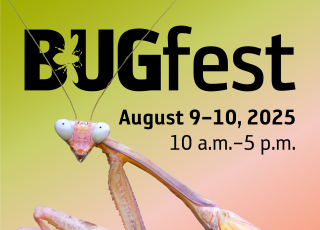NHMU Displays the Magnificent Macro Photography of Levon Biss
‘Microsculpture’ showcases both art and science through striking portraits of insects
July 2, 2024, Salt Lake City - Microsculpture: The Insect Portraits of Levon Biss, a captivating photographic exhibition that reveals the intricate beauty of insects on an unprecedented scale, will be on display at the Natural History Museum of Utah (NHMU) July 2, 2024, through September 15, 2024. Microsculpture showcases the stunning work of award-winning British photographer Levon Biss, renowned for his mesmerizing portraits of insects captured in astonishing detail.
Each image in the exhibition is a high-resolution composite of over 8,000 individual photographs, revealing the microscopic beauty of each subject. From beetles to butterflies, Biss’s meticulous process highlights textures and colors that are not visible to the naked eye, offering viewers a rare glimpse into the hidden world of insects. In addition to Biss’ phenomenal insect images, on display will be insect specimens and their portraits from NHMU’s entomology collection – the largest in Utah, captured as part of NHMU’s multi-year digitization initiative. This project has made many of NHMU’s collections available online to users worldwide.
“Microsculpture highlights the intersection of science and art in a visually stunning experience," said Dr. Jason Cryan, The Sarah B. George Executive Director at NHMU and an entomologist himself. "This exhibition promises to inspire curiosity and appreciation for an amazing part of the natural world that relatively few people have seen. Levon Biss’s work not only showcases the incredible diversity of insects but also encourages visitors to see insects in a new light."
Visitors will explore large-scale prints that bring insects to life in vivid detail, accompanied by informative panels that delve into the unique science behind Biss’s photographic technique. Interactive displays offer a deeper understanding of the intricate structures and behaviors of these often-overlooked creatures.
Levon Biss rose to prominence as a portrait photographer with his work appearing on the covers of TIME, The New York Times, GQ, and Sports Illustrated. Through Microsculpture, Biss has become widely regarded as the leading macro photographer of his generation. Biss developed the Microsculpture project which showcases the insect collection of the Oxford University Museum of Natural History, as an outlet for his passions of photography and natural history.
Microsculpture: The Insect Portraits of Levon Biss is made possible through the generous support of Major Sponsor Rio Tinto Kennecott, Exhibit Sponsor The Meldrum Foundation, a Community Sponsor gift in memory of Jane L. Parker, and the Salt Lake County Zoo, Arts, & Parks (ZAP) Program. The exhibition will be open to the public from July 2, 2024, through September 15, 2024, in NHMU’s special exhibition gallery and is included with Museum admission. Tickets can be purchased in advance at nhmu.utah.edu/visit.
###
About the Natural History Museum of Utah
The Natural History Museum of Utah is one of the leading scientific research and cultural institutions in the country. Established in 1963, the museum’s 10 permanent exhibitions are anchored by its state-of-the-art collections and research facilities containing almost 2 million objects. These collections are used in studies on geological, biological, and cultural diversity, and the history of living systems and human cultures within the Utah region. The museum hosts approximately 300,000 general visitors a year and provides one of the most spectacular private event settings in the Salt Lake City area. NHMU also broadens the reach of its mission through a variety of science-based outreach programs to communities and schools throughout Utah, reaching every school district in the state every other year.
Download Media
-
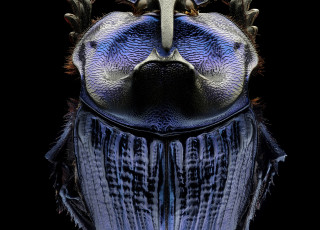
Coprophanaeus lancifer (Coleoptera, Scarabaeidae).
This large and impressive scarab beetle is found widely across the Amazon Basin. This species is particularly active at dusk when the contrast in color between the black horn and the blue body is enhanced and helps individuals to recognize others of the same species. Although belonging to a group of scarab beetles which mainly consume dung this and related species have switched to feeding on dead animals. The toothed, blade-like area at the front of the head and the serrated front legs are thought to help in breaking up tough carrion. Credit: © Levon Biss -
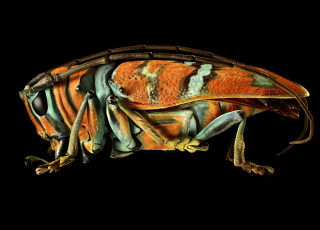
Species of the genus Sternotomis (Coleoptera, Cerambycidae).
Once magnified the secret to the spectacular patterning of this beetle is revealed – a covering of extremely fine pigmented scales similar to those of butterflies and moths. Credit: © Levon Biss -
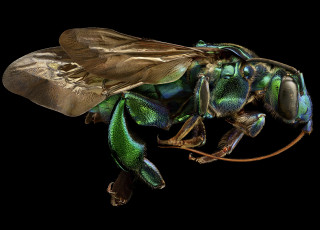
Exaerete frontalis (Hymenoptera, Apidae).
The Orchid Cuckoo Bee of the most spectacular of all bees in terms of size, color and microsculpture. We usually think of bees as benign, helpful creatures, but Exaerete is a cuckoo bee. Instead of collecting pollen and constructing their own nests, female cuckoo bees enter the nests of other bees and lay their eggs in the host’s brood cells. This particular specimen has grown to a large size by consuming the pollen diligently collected by its host. Credit: © Levon Biss -
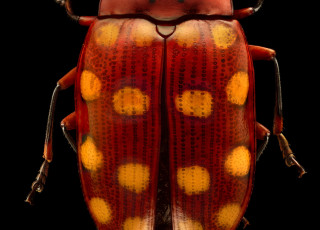
Species of the genus Brachysphaenus (Coleoptera, Erotylidae).
Close relatives of ladybirds, species of pleasing fungus beetles show a seemingly endless combination of bright colors, spots, stripes and other patterns. Their attractive colors are not there to please humans of course; rather the striking decoration advertises a sophisticated chemical defense system to predators. Credit: © Levon Biss -
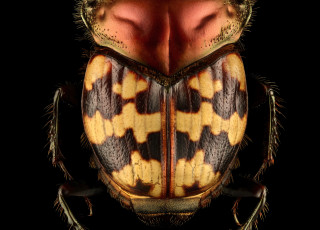
Helictopleurus splendidicollis (Coleoptera, Scarabaeidae)
Arguably the most attractively marked dung beetle in the world, it is thought that after the extinction of all the large animals on Madagascar this beetle survived by switching from feeding on dung to feeding on dead animals. Credit: © Levon Biss -
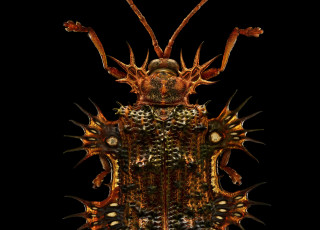
Platypria melli (Coleoptera, Chrysomelidae).
The wonderfully complex shape of the Tortoise Beetle is a composite of bumps, pits, wrinkles and rows of spines. Light passing through the specimen further reveals areas where the wing cases are paper-thin. The function of the spines is unclear but can be assumed to be a physical defense or to help camouflage the insect on its host plant. Credit: © Levon Biss

